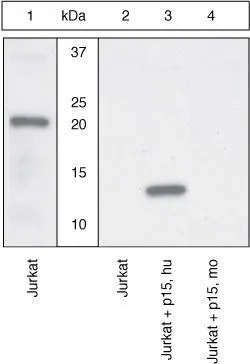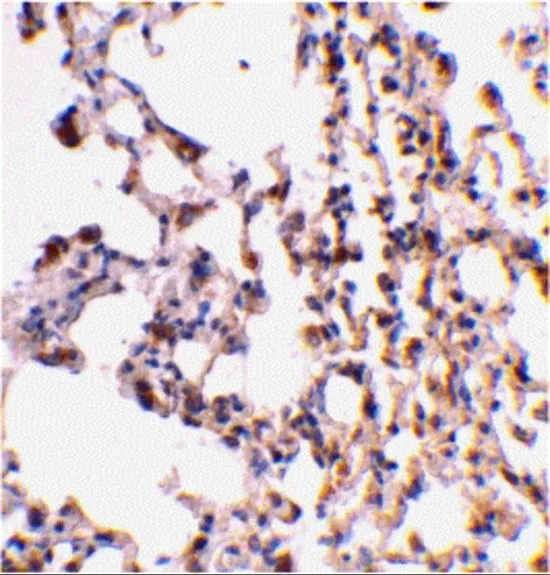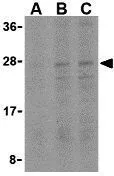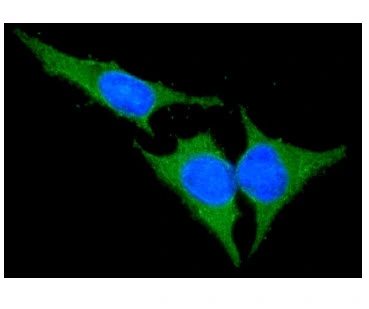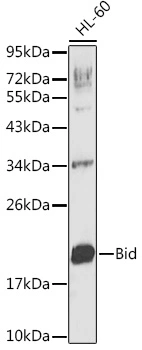![ELISA analysis of antigen using GTX60429 Bid antibody [3C5]. Red : Control antigen 100ng Purple : Antigen 10ng Green : Antigen 50ng Blue : Antigen 100ng ELISA analysis of antigen using GTX60429 Bid antibody [3C5]. Red : Control antigen 100ng Purple : Antigen 10ng Green : Antigen 50ng Blue : Antigen 100ng](https://www.genetex.com/upload/website/prouct_img/normal/GTX60429/GTX60429_20170912_ELISA_w_23061123_666.webp)
ELISA analysis of antigen using GTX60429 Bid antibody [3C5]. Red : Control antigen 100ng Purple : Antigen 10ng Green : Antigen 50ng Blue : Antigen 100ng
Bid antibody [3C5]
GTX60429
ApplicationsFlow Cytometry, ImmunoFluorescence, Western Blot, ELISA, ImmunoCytoChemistry, ImmunoHistoChemistry, ImmunoHistoChemistry Paraffin
Product group Antibodies
TargetBID
Overview
- SupplierGeneTex
- Product NameBid antibody [3C5]
- Delivery Days Customer9
- Application Supplier NoteWB: 1/500 - 1/2000. ICC/IF: 1/200 - 1/1000. IHC-P: 1/200 - 1/1000. FACS: 1/200 - 1/400. ELISA: 1/10000. *Optimal dilutions/concentrations should be determined by the researcher.Not tested in other applications.
- ApplicationsFlow Cytometry, ImmunoFluorescence, Western Blot, ELISA, ImmunoCytoChemistry, ImmunoHistoChemistry, ImmunoHistoChemistry Paraffin
- CertificationResearch Use Only
- ClonalityMonoclonal
- Clone ID3C5
- ConjugateUnconjugated
- Gene ID637
- Target nameBID
- Target descriptionBH3 interacting domain death agonist
- Target synonymsFP497, BH3-interacting domain death agonist, Human BID coding sequence, apoptic death agonist, desmocollin type 4, p22 BID
- HostMouse
- IsotypeIgG1
- Protein IDP55957
- Protein NameBH3-interacting domain death agonist
- Scientific DescriptionThis gene encodes a death agonist that heterodimerizes with either agonist BAX or antagonist BCL2. The encoded protein is a member of the BCL-2 family of cell death regulators. It is a mediator of mitochondrial damage induced by caspase-8 (CASP8); CASP8 cleaves this encoded protein, and the COOH-terminal part translocates to mitochondria where it triggers cytochrome c release. Multiple alternatively spliced transcript variants have been found, but the full-length nature of some variants has not been defined. [provided by RefSeq, Jul 2008]
- Storage Instruction-20°C or -80°C,2°C to 8°C
- UNSPSC12352203
References
- Ivermectin induces cell cycle arrest and caspase-dependent apoptosis in human urothelial carcinoma cells.Read more

![FACS analysis of HeLa cells using GTX60429 Bid antibody [3C5]. Green : Bid Purple : negative control FACS analysis of HeLa cells using GTX60429 Bid antibody [3C5]. Green : Bid Purple : negative control](https://www.genetex.com/upload/website/prouct_img/normal/GTX60429/GTX60429_20170912_FACS_w_23061123_739.webp)
![ICC/IF analysis of HeLa cells using GTX60429 Bid antibody [3C5]. Green : Bid Blue: DRAQ5 fluorescent DNA dye Red: Actin filaments ICC/IF analysis of HeLa cells using GTX60429 Bid antibody [3C5]. Green : Bid Blue: DRAQ5 fluorescent DNA dye Red: Actin filaments](https://www.genetex.com/upload/website/prouct_img/normal/GTX60429/GTX60429_20170912_ICCIF_w_23061123_825.webp)
![IHC-P analysis of human prostate tissue (left) and tonsil tissue (right) using GTX60429 Bid antibody [3C5]. IHC-P analysis of human prostate tissue (left) and tonsil tissue (right) using GTX60429 Bid antibody [3C5].](https://www.genetex.com/upload/website/prouct_img/normal/GTX60429/GTX60429_20170912_IHC-P_w_23061123_846.webp)
![WB analysis of HeLa (1), A431 (2), Jurkat (3), A549 (4), HepG2 (5), and HEK293 (6) cell lysate using GTX60429 Bid antibody [3C5]. WB analysis of HeLa (1), A431 (2), Jurkat (3), A549 (4), HepG2 (5), and HEK293 (6) cell lysate using GTX60429 Bid antibody [3C5].](https://www.genetex.com/upload/website/prouct_img/normal/GTX60429/GTX60429_20170912_WB_w_23061123_361.webp)
![WB analysis of 0.125-1ug purified BID-GST fusion protein using GTX15667 Bid antibody [23F7]. Dilution : 1:1000](https://www.genetex.com/upload/website/prouct_img/normal/GTX15667/GTX15667_2070_WB_w_23060620_524.webp)
